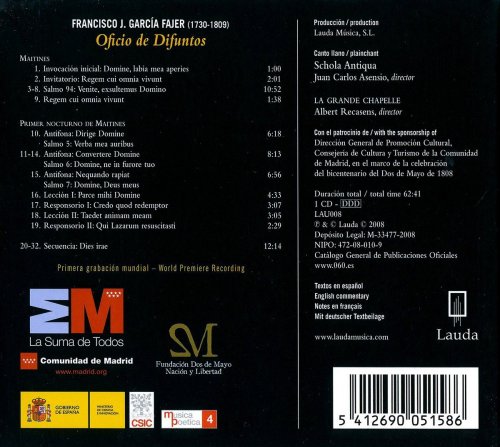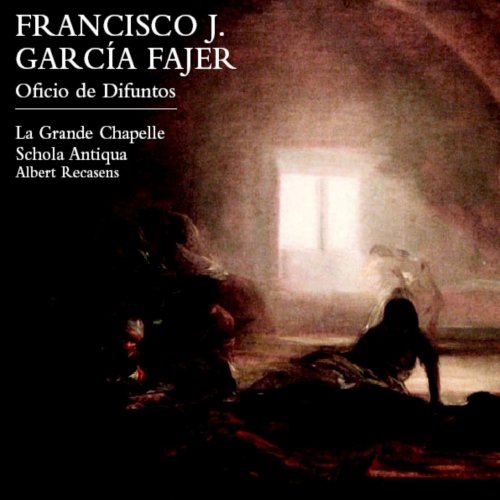
Albert Recasens, La Grande Chapelle, Schola Antiqua - Francisco Javier García Fajer: Oficio de Difuntos (2011)
BAND/ARTIST: Albert Recasens, La Grande Chapelle, Schola Antiqua
- Title: Francisco Javier García Fajer: Oficio de Difuntos
- Year Of Release: 2008
- Label: Lauda Música
- Genre: Classical
- Quality: flac lossless (tracks) +Booklet
- Total Time: 01:02:56
- Total Size: 282 mb
- WebSite: Album Preview
Tracklist
01. Maitines: Invocación inicial-Domine labia mea aperies
02. Maitines: Invitatorio-Regem cui omnia vivunt
03. Maitines: Salmo 94-Venite, exsultemus Domino-Allegreto
04. Maitines: Salmo 94-Quoniam Deus Magnus, Largo
05. Maitines: Salmo 94-Quoniam ipsius est mare, Allegro poco
06. Maitines: Salmo 94-Hodie si vocem, Andante
07. Maitines: Salmo 94-Quadraginta annis, Allegro
08. Maitines: Salmo 94-requiem aeternam, Largo
09. Maitines: Salmo 94-Regem cui omnia vivunt, Largo
10. Primer Nocturno de Maitines: Antifona-Dirige Domine; Salmo 5: Verba mea auribus
11. Primer Nocturno de Maitines: Antifona-Convertere Domine-Salmo 6: Domine, ne in furore tuo; Allegro
12. Primer Nocturno de Maitines: Antifona-Convertere Domine-Salmo 6: Domine ne in furore tuo: Laboravi in gemitu meo, Largo
13. Primer Nocturno de Maitines: Antifona-ConvertereDomine-Salmo 6: Discedite a me omnes, Largo
14. Primer Nocturno de Maitines: Antifona-Convertere Domine-Salmo 6: Requiem aeternam, Largo
15. Primer Nocturno de Maitines: Antifona-Nequando rapiat-Salmo 7: Domine, Deus meus
16. Primer Nocturno de Maitines: Lección I-Parce mihi Domine
17. Primer Nocturno de Maitines: Responsorio I-Credo quod reddemptor
18. Primer Nocturno de Maitines: Lección II-Taedet animam meam
19. Primer Nocturno de Maitines: Responsorio II-Qui Lazarum resuscitasti
20. Primer Nocturno de Maitines: Secuencia, Dies irae
21. Primer Nocturno de Maitines: Secuencia-Dies irae, Quantus tremor
22. Primer Nocturno de Maitines: Secuencia-Dies irae: Tubu mirum
23. Primer Nocturno de Maitines: Secuencia-Dies irae: Mors stupebit
24. Primer Nocturno de Maitines: Secuencia-Dies irae: Liber scriptus
25. Primer Nocturno de Maitines: Secuencia-Dies irae: Rex tremendae
26. Primer Nocturno de Maitines: Secuencia-Dies irae: Recordare Iesu pie
27. Primer Nocturno de Maitines: Secuencia-Dies irae: Qui Mariam
28. Primer Nocturno de Maitines: Secuencia-Dies irae: Inter oves
29. Primer Nocturno de Maitines: Secuencia-Dies irae: Confutatis
30. Primer Nocturno de Maitines: Secuencia-Dies irae: Oro supplex
31. Primer Nocturno de Maitines: Secuencia-Dies irae: Lacrimosa
32. Primer Nocturno de Maitines: Secuencia-Dies irae: Huic ergo

This is the world’s first recording of the Oficio de Difuntos (the Office of the Dead) by “el Españoleto”, one of the most important composers in the history of Spanish music before 1800, whose work enjoyed great prestige in his lifetime and was widely circulated in both Spain and Latin America.
Francisco Javier Garcia Fajer (1730-1809), better known as “el Españoleto” is one of the great names in Spanish music of the 18th century. He was born in La Rioja but trained in Italy and was Chapel Master in La Seo Cathedral in Zaragoza for 53 years. During his stay in Italy Garcia Fajer wrote at least two oratories and four operas although in Spain his output was mainly of religious pieces. His music was very widely disseminated, as attested to by the copies that are preserved in several Spanish and American cities.
The Oficio de Difuntos itself comes from the archives of Guadalupe (Mexico) and Lima (Perú) and has been revived by La Grand Chapelle. It is composed of two psalms and two readings of the first nocturn of matins. Fajer’s office is written for eight voices with violins, flutes, horns and basso continuo and is characterized by its melodic sweetness, simple harmonics and formal clarity, each at the service of the liturgical texts for which they were conceived. The music has been contextualized by including Gregorian responses and antiphons taken from a Prontuario of 1799-1800; a labour which was undertaken by Juan Carlos Asensio who is also the leader of Schola Antiqua. The Cd is completed with the Dies irae sequence attributed to Fajer and preserved in the church of Madre di Enna (Sicily).
The present recording provides the first opportunity to hear the highly interesting Office of the Dead by one of the composers most in tune with international developments in the years leading up to the War of Independence. It provides evidence that Spain was not as musically isolated as others have claimed and that this composer from La Rioja, while still including late baroque and rococo elements, had completely assimilated the classical style without leaving aside the Spanish musical tradition.
01. Maitines: Invocación inicial-Domine labia mea aperies
02. Maitines: Invitatorio-Regem cui omnia vivunt
03. Maitines: Salmo 94-Venite, exsultemus Domino-Allegreto
04. Maitines: Salmo 94-Quoniam Deus Magnus, Largo
05. Maitines: Salmo 94-Quoniam ipsius est mare, Allegro poco
06. Maitines: Salmo 94-Hodie si vocem, Andante
07. Maitines: Salmo 94-Quadraginta annis, Allegro
08. Maitines: Salmo 94-requiem aeternam, Largo
09. Maitines: Salmo 94-Regem cui omnia vivunt, Largo
10. Primer Nocturno de Maitines: Antifona-Dirige Domine; Salmo 5: Verba mea auribus
11. Primer Nocturno de Maitines: Antifona-Convertere Domine-Salmo 6: Domine, ne in furore tuo; Allegro
12. Primer Nocturno de Maitines: Antifona-Convertere Domine-Salmo 6: Domine ne in furore tuo: Laboravi in gemitu meo, Largo
13. Primer Nocturno de Maitines: Antifona-ConvertereDomine-Salmo 6: Discedite a me omnes, Largo
14. Primer Nocturno de Maitines: Antifona-Convertere Domine-Salmo 6: Requiem aeternam, Largo
15. Primer Nocturno de Maitines: Antifona-Nequando rapiat-Salmo 7: Domine, Deus meus
16. Primer Nocturno de Maitines: Lección I-Parce mihi Domine
17. Primer Nocturno de Maitines: Responsorio I-Credo quod reddemptor
18. Primer Nocturno de Maitines: Lección II-Taedet animam meam
19. Primer Nocturno de Maitines: Responsorio II-Qui Lazarum resuscitasti
20. Primer Nocturno de Maitines: Secuencia, Dies irae
21. Primer Nocturno de Maitines: Secuencia-Dies irae, Quantus tremor
22. Primer Nocturno de Maitines: Secuencia-Dies irae: Tubu mirum
23. Primer Nocturno de Maitines: Secuencia-Dies irae: Mors stupebit
24. Primer Nocturno de Maitines: Secuencia-Dies irae: Liber scriptus
25. Primer Nocturno de Maitines: Secuencia-Dies irae: Rex tremendae
26. Primer Nocturno de Maitines: Secuencia-Dies irae: Recordare Iesu pie
27. Primer Nocturno de Maitines: Secuencia-Dies irae: Qui Mariam
28. Primer Nocturno de Maitines: Secuencia-Dies irae: Inter oves
29. Primer Nocturno de Maitines: Secuencia-Dies irae: Confutatis
30. Primer Nocturno de Maitines: Secuencia-Dies irae: Oro supplex
31. Primer Nocturno de Maitines: Secuencia-Dies irae: Lacrimosa
32. Primer Nocturno de Maitines: Secuencia-Dies irae: Huic ergo

This is the world’s first recording of the Oficio de Difuntos (the Office of the Dead) by “el Españoleto”, one of the most important composers in the history of Spanish music before 1800, whose work enjoyed great prestige in his lifetime and was widely circulated in both Spain and Latin America.
Francisco Javier Garcia Fajer (1730-1809), better known as “el Españoleto” is one of the great names in Spanish music of the 18th century. He was born in La Rioja but trained in Italy and was Chapel Master in La Seo Cathedral in Zaragoza for 53 years. During his stay in Italy Garcia Fajer wrote at least two oratories and four operas although in Spain his output was mainly of religious pieces. His music was very widely disseminated, as attested to by the copies that are preserved in several Spanish and American cities.
The Oficio de Difuntos itself comes from the archives of Guadalupe (Mexico) and Lima (Perú) and has been revived by La Grand Chapelle. It is composed of two psalms and two readings of the first nocturn of matins. Fajer’s office is written for eight voices with violins, flutes, horns and basso continuo and is characterized by its melodic sweetness, simple harmonics and formal clarity, each at the service of the liturgical texts for which they were conceived. The music has been contextualized by including Gregorian responses and antiphons taken from a Prontuario of 1799-1800; a labour which was undertaken by Juan Carlos Asensio who is also the leader of Schola Antiqua. The Cd is completed with the Dies irae sequence attributed to Fajer and preserved in the church of Madre di Enna (Sicily).
The present recording provides the first opportunity to hear the highly interesting Office of the Dead by one of the composers most in tune with international developments in the years leading up to the War of Independence. It provides evidence that Spain was not as musically isolated as others have claimed and that this composer from La Rioja, while still including late baroque and rococo elements, had completely assimilated the classical style without leaving aside the Spanish musical tradition.
Year 2021 | Classical | FLAC / APE
As a ISRA.CLOUD's PREMIUM member you will have the following benefits:
- Unlimited high speed downloads
- Download directly without waiting time
- Unlimited parallel downloads
- Support for download accelerators
- No advertising
- Resume broken downloads


